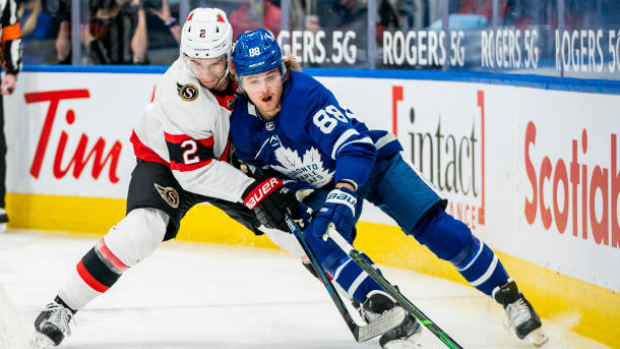Feb 17, 2021
Zub off to strong start for Senators
Russian rookie defenceman’s considerable impact at both ends of the ice for Ottawa has made him one of the bigger surprises in hockey, Travis Yost writes.
By Travis Yost

Ottawa Senators head coach D.J. Smith remarked on Wednesday that he thought defenceman Mike Reilly had been his best blueliner over the past few weeks, excluding the heavily deployed Thomas Chabot and Nikita Zaitsev pairing.
Reilly has been playing much better of late, and it’s also true that the Chabot-Zaitsev pairing tends to take on the lion’s share of minutes for an Ottawa team still trying to fight its way to some degree of competitiveness and respectability.
But if you asked me who Ottawa’s best defender had been over the course of this season, the answer so far might be 25-year-old Russian rookie Artem Zub.
Zub signed a one-year, entry-level contract with the Senators last May, and has been one of the bigger surprises in hockey. The 6-foot-2, 200-pound defenceman has had a considerable impact at both ends of the ice. He’s shown himself to be a very capable puck-mover (something sorely missing on Ottawa’s battered blueline) as expected, but he’s also illustrated an ability to defend at the highest professional level.
Perhaps Zub’s impressive two-way game is a result of his late arrival to the NHL. Zub played for years with SKA Saint Petersburg in the KHL, which means plenty of experience against real talent.
For example, his first season with SKA Saint Petersburg (2016-17) saw him playing with the likes of Ilya Kovalchuk, Evgenii Dadonov, Vadim Shipachyov, Nikita Gusev and Pavel Datsyuk – to just name a few.
At any rate, Zub has the look of a top-four defender. If you compare Ottawa’s net results with each of their defenders on the ice this season, there really isn’t a competition. The Senators are substantially better with Zub on the ice relative to any other option at even strength:

Zub is the only player who is above water in net-goal differential this season, with the Senators outscoring opponents six to four (+2) in eight games with the Russian defender on the ice. Some of that goal differential is being driven by the fact that Zub came into the lineup after an early goaltending disaster in Ottawa – his 90.3 on-ice save percentage, which is still below league average, looks otherwise Herculean on this team.
But put away the goals for a minute. The Senators are +36 in shot differential with Zub on the ice, whereas the rest of the Ottawa lineup is -32 in their respective minutes. And the Senators are +11 in scoring chances with Zub on the ice, compared to -33 with him off.
Ultimately, this is why the shot profiles with Zub on the ice – his partner being veteran defender Mike Reilly and his common linemates including Dadonov, Colin White, and Nick Paul – are relatively strong on both ends of the ice.
It’s particularly been true on the defensive side. Compare Ottawa’s shot profile at the team level against their shot profile with Zub on the ice.
It’s night and day, again:

The point Smith made about the Chabot and Zaitsev pairing is an important one. Ottawa is still a bad team, and that means its top pairing is frequently exposed to the most talented opposition attacking units in the North Division, which can have a stifling impact on performance. Zub, tied to Rielly and away from top-pairing minutes, is going to have an easier run of competition.
But even that gap isn’t a significant one. If you looked at Zub’s most common forward opponent by team this year, it’s Edmonton’s Leon
Draisaitl (the reigning Hart Memorial Trophy winner), Montreal’s Josh Anderson, Toronto’s Auston Matthews, and Winnipeg’s Paul Stastny.
That’s indicative of a trust and belief from the coaching staff that the pairing can handle minutes against top-six forwards with a degree of regularity, and so far, so good.
Eight games remain just eight games, but I’m not sure Zub’s career could be off to a better start. It’s easy to look relatively good as a defenceman in Ottawa, which has struggled mightily with roster composition on the back end.
But Zub looks good even by league average standards over this span, and there is no reason to believe he will leave the Senators lineup anytime soon.
Data via Natural Stat Trick, Evolving Hockey, NHL.com

